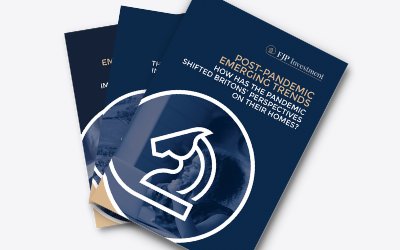A Breakdown of the Latest Landlord Survey (May 2022)
The latest annual nationwide survey of private landlords and renting agents in England, conducted by the English Private Landlord Survey (EPLS) and commissioned by the Department of Levelling up, Housing and Urban Development & Peoples (DLUHC) has recently been released. The purpose of the landlord survey is to help the UK government better understand landlord qualities and experiences, as well as how they obtain, lease, and manage property of privately rented housing.
Principal Findings
A total of 3.9 million active deposits have been recorded with one of the three government-backed Tenancy Deposit Protection programmes in England. Approximately 438,000 people were registrant landlord or agents. Some of these (approximately 408,000) landlords had registered the deposits in their own names.
- TDP programmes cover between 59 and 77 percent of households in the private lease sector.
Over half of all rental properties were owned by landlords with five or more properties, but just a little less than half of all landlords owned just one rental property.
- 43% of landlords own one rental property, which accounts for 20% of all rentals
- It was found that 39% owned 2-4 rental properties, accounting for 31% of all tenancies
- 18% of landlords had five or more properties, which accounted for over half of all tenancies
Individual landlords have smaller portfolios than those who own properties through corporations or organisations.
- Over 85% of individual landlords had between one and four rental homes, and just under half (45%) of these landlords had only one rental home
- Less than half of landlords who operated as corporations or organisations held 1–4 properties. More than half of the respondents (56 percent) owned five or more properties
Individually, there are more male than female landlords, and the portfolios of male landlords tend to be bigger. Broken down, the data reveals:
- There were 55% of landlords who identified as male and 44% who identified as female
- Women were more likely to possess a single rental home than men – 55% of landlords with one property were female, compared to just 45% of landlords with one being male. Male landlords, on the other hand, accounted for a greater percentage of those with two or more properties in their portfolio

In contrast to more than half of landlords who purchased their property fully intending to rent it out, a little over a third acquired their first rental property for their own use before renting it out.
- Over half (52 percent) of new landlords purchased their first home with the intention of renting it out
- More than a third of first-time home buyers (35%) purchased their first home for personal use
- Only 7% of landlords began their investment portfolio by inheriting their first rental property, while 1% received their first rental property as a gift
Rents established by landlords for new renters were more likely to rise above the amount at which the property had previously been rented. When landlords renewed existing leases, they were more likely to keep the rent the same than to raise it.
- For new tenants, over half of landlords (45%) stated they increased the rent, but only 35% of landlords left the rate the same, and only 8% of landlords reduced the rent from previous levels. Only 12% of landlords said that their most recent lease was the property’s first time being rented out
- 64 percent of landlords kept the same rent rate, 26% raised it, and 4% reduced the rent on renewal for existing tenants
In the past 12 months, the most regularly used eviction notice by landlords was the s. 21 notice (no fault eviction). Some 25 percent indicated they used a Section 8 notice, which means the renter has violated the terms of their lease.
- Nearly two-thirds (67%) of landlords who evicted or ordered their tenants to leave in the previous year issued Section 21 notices, and one out of every four tenants (25%) received Section 8 notices. In the event that a tenant has violated the conditions of their tenancy, this is where landlords might issue this notice
- 27% of landlords asked their renters to leave in a friendly, informal way, and 5% of them offered to pay them to leave
Most landlords returned deposits in full or in part at the end of their most recent rental.Only a few people claimed to have kept their whole deposit.
- More than half (62%) of landlords have returned the full deposit once the tenancy comes to an end. Nearly a quarter (22%) of the deposits were refunded in part
- Just 3% did not return any of the deposit, and under a tenth (9%) said they returned none of the deposit and the costs at the end of their last tenancy exceeded the deposit
The effect of the COVID-19 pandemic
Due to the COVID-19 epidemic, landlords reported having an average of one renter in arrears. Tenants who owed their landlords more money were more likely to have larger portfolios.
- Landlords have reported an average of one tenant falling behind on their rent as a result of the COVID-19 outbreak. Nearly a third of landlords (29 percent) reported no arrears from their tenants
- Landlords with only one property were more likely to have one tenant in arrears (67%) or no tenants behind (29%). 15% of landlords with two to four properties and 38% of those with five or more properties had more than one tenant in arrears, respectively
According to the majority of landlords, tenants did not tend to request new rent arrangements during the COVID-19 outbreak. A decreased rent or postponed rent with a repayment plan were the most common arrangements made by those who did.
- During the COVID-19 outbreak, 72 percent of landlords reported that no renters requested a new rent agreement. One-fifth (18%) of respondents said they renegotiated their lease with a single renter, while 9% said they renegotiated their lease with multiple tenants
- Of those who agreed to a new arrangement, 49% said this consisted of a reduced
- According to 31% of respondents, the arrangement included deferred rent with a repayment plan
ARE YOU READY TO START INVESTING?
Subscribe to our mailing list now for exclusive deals, investment guides and the latest information from the property market.







